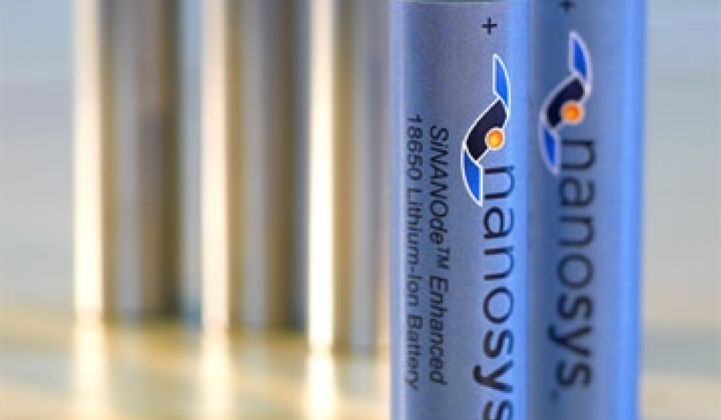As part of its push into energy, Samsung has crafted an alliance with a company that was given up for dead not too long ago.
The South Korean giant's VC arm has invested $15 million into Nanosys, which specializes in nanomaterials, and the two companies will collaborate on future products. Samsung also obtained a license for Nanosys' intellectual property. Ideally, the alliance will lead to new materials to increase the efficiency of solar panels, better LEDs, energy-efficient computer screens and computer memory.
The deal further underscores Samsung's concerted push into energy. The company last year unfurled an ambitious plan to become a leader in the field and even stated a goal of becoming the largest solar producer in the world by 2015 from a current base of effectively zero. It followed quickly with an announcement that it would invest $6.6 billion in Ontario on solar power plants and manufacturing centers. The goal is now to invest $20 billion in green worldwide and hire 45,000 workers. If you aren't afraid, you should be. The company is relentless when it comes to execution on a plan (you can read more about Samsung's dramatic history here).
While the name 'Nanosys' will still make many scoff, it's an impressive friend to win and helps bolster a comeback effort that was underway about a year ago. In the middle of the last decade, the company epitomized the promise, arrogance and general lack of focus in the emerging world of nanotechnology. The company amassed millions in venture capital and aligned itself with some of the top researchers in the world -- including Paul Alivisatos of the University of California, who is part of the Steve Chu/ UC Berkeley energy mafia, and Harvard's Charlie Lieber.
Conglomerates like Mitsubishi inked research development deals with them, and the firm filed for an IPO in 2004.
Nanosys then quickly yanked it. Although the market was rising then, investors didn't show much of a taste for a company that lost money at a regular clip, only had about 34 employees, and wanted to go out at $15 to $17 a share. The jokes and comments followed. Many of the members of the management team fled or were shown the door.
Starting in 2009, the company shifted away from licensing intellectual property, always a daunting challenge, to actually making and selling components based on its own technology. Nanosys still tries to license technology, but there is a greater emphasis on things that are drop-in replacements for traditional components.
It also reduced the scope of its research to focus on just a few things. One project, for instance, is a filter for light-emitting diodes that improves the quality of light in white LEDs. White LEDs generally consist of a blue light LED covered by a filter coated with a yellow phosphor. While the phosphor-coated lens turns the light white, it is a clinical, "cold" white light. "Alien autopsy" is one way to describe it.
Nanosys' LED filter contains a quantum dot lens turns the blue light into a "warm" white light that resembles the kind of light that comes out of a regular incandescent bulb. The company is also trying to sell silicon nanowires, which grew out of research conducted by Lieber, as a component for anodes in lithium-ion batteries (see photo).
How will Samsung and Nanosys develop products? It's hard to say. Samsung could end up just using a portion of the intellectual product portfolio. Conversely, Nanosys could design components for Samsung and license the intellectual property or license technology and provide magic powders.
Intellectual property deals have been springing up quite a bit lately. Innovalight has signed deals to license intellectual property and sell silicon ink to two chinese solar makers, a hybrid of the usual IP business model. Innova Dynamics, which wants to embed particles into solar panels, and Contour Energy Systems, which has a novel fluorine battery, are both thinking of doing something similar.
Other Asian conglomerates -- Panasonic, TSMC, Toshiba -- have outlined similar plans to expand into green technology. Panasonic is already a leader in solar panels and batteries. TSMC has been scouting Silicon Valley for startups to invest in. LG Chem makes batteries for both Ford and GM.
These companies all have worldwide sales and manufacturing footprints, and in many green markets, logistics and supply chains play crucial roles. Green companies are far less virtual than Web 2.0 startups. Just as important, many Asian conglomerates, particularly Japanese ones, already have long histories in energy and energy efficiency.
For many, it could be like a return of the 1980s.



